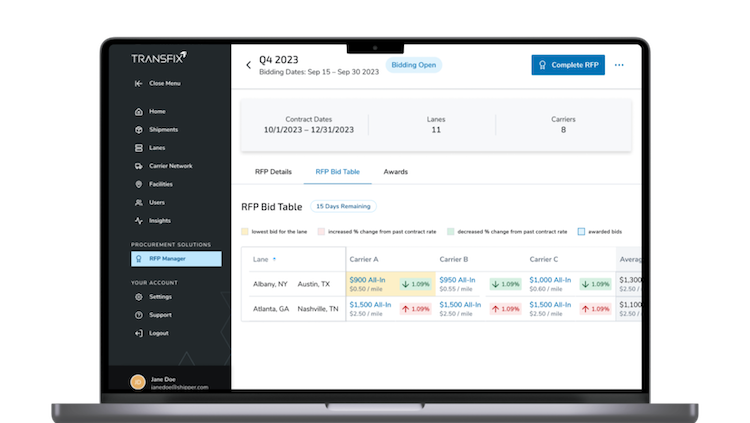Consider that 3.5 million truck drivers moved 11.84 billion tons of freight in 2019 – that’s three quarters of all freight moved in the United States. Truckers carry our economy on their wheels and 97% of them are small and mid-sized carriers. However, these small businesses that play a critical role in our economy usually do not have the resources to build technology that help them manage their fleet with much more efficiency and ease. As a result, they find a way to get it done through manual processes such as using spreadsheets or notepads to manage their day-to-day operations.
At Transfix, we view ourselves as long-term partners to our carriers. That’s why we built Fleet Planner, a free online tool that empowers carriers to run their businesses by helping them secure the best loads, centralize their fleet management activities and keep a pulse on the health of their business.
Below Sunny Shah, Senior Product Manager, goes behind the scenes to discuss the pain points he heard from dispatchers, the thought and process behind building Fleet Planner, and how he sees the product evolving in the future.
1. In sitting with fleet managers and dispatchers over the last year, what were some of the challenges they were facing in managing their fleet?
It became very clear that there aren’t enough hours in the day for dispatchers. They do so much ranging from booking loads with brokers and customers, communicating load info with drivers, tracking loads and updating their brokers and customers on the status, and communicating their fleet’s status with their managers.
When we looked at the tools dispatchers use on a day to day basis, we found they could be 10x better. Often, they’re using notepads, spreadsheets, and whiteboards to manage driver schedules and load information. Many of the dispatchers I spoke with recognized there had to be a better way to manage their work. Of course, in between fighting fires and their day-to-day work, it’s tough to push for change and find the time to try something new.
2. Can you explain one of the more complicated ways a fleet manager would work with their drivers to book and communicate loads step by step?
Let’s take the example of finding spot loads for Owner Operators. First, the dispatcher will spend the day scanning load boards and bouncing between calls from brokers. When there’s a load opportunity that seems interesting, they get on the phone with the Owner Ops to share details and gauge their interest. If there is interest, the dispatcher will go book the load. Once the load is booked, the dispatcher will then share more specific details about the load with the Owner Op by typing out a text message. If anything changes about that load, the dispatcher will have to resolve this either over the phone or while texting the Owner Op.
The constant back and forth texts and phone calls, especially when load information changes, is both an incredibly manual process and makes it very easy to lose track of up-to-date load information.
3. Why did you and the team decide to build Fleet Planner? Why did you focus specifically on small to mid-sized carriers?
First and foremost, we want to help carriers grow their businesses! Small and mid-sized carriers represent an overwhelming majority of the U.S. carrier base yet there are very few software solutions built for smaller carriers. That’s why we wanted to focus on this group. We spoke to dozens of carriers 1-on-1 and learned about their many challenges.
We saw that small and mid-sized carriers struggled with:
- Razor thin profit margins on their loads
- Highly manual workflows and processes to manage their fleet
- Limited time to think about and invest in growing their business
Given our expertise in product and technology, we felt we could build a modern, easy to use fleet management solution that would help these carriers grow and run their business. Since then, we’ve been working with dispatchers across the country to design and build the product we have today, and we continue to work with them to improve our product going forward.
4. How did you decide which features to build first? What were the must have features?
Our goal was to help carriers run their business off of Fleet Planner. In order to do that, we needed to have a clear picture of their business.
Practically, this translated to helping dispatchers represent their loads and driver schedules on one screen. Once we built that functionality, we had the freedom to build really interesting experiences that would remove manual work we noticed dispatchers doing. For example, we allow dispatchers to share load details with their drivers with the click of a button instead of them having to type out and text all the details.
5. As we continue to garner feedback from our dispatchers and fleet managers, where do you see Fleet Planner evolving?
I firmly believe that Fleet Planner will help carriers run and grow their entire business. I see us continuing to build out the core aspects of a fleet management software such as integrations and analytics, while taking every opportunity to delight users with features that will reduce manual effort and increase visibility. Our goal at the end of the day is to help carriers run more successful businesses, and their needs dictate what we build.
6. What do you think will be the most valuable part of Fleet Planner to its users as you continue to build the product?
I see three aspects of Fleet Planner that will be beneficial to carriers.
First is centralization of data. Right now, load information and other details live in many spreadsheets, pieces of paper, and multiple apps. We’re going to bring all that information into one place to reduce the level of searching and management required for dispatchers.
Second is searching and securing the best loads for your business. We’re planning to bring the world’s largest supply of loads to your fingertips and, better yet, help you find the loads that best match your schedule, operating requirements, and driver preferences.
Third is analytics. It’s difficult for carriers to link their income and expenses to real business activities. We’re planning to bridge that gap so that each dispatcher and fleet owner can make the best business decisions for their company.
Tired of using spreadsheets and notepads to manage your fleet? Sign-up for Fleet Planner here. If you’re a carrier interested in helping us create the best product for carriers, email us here.
About Sunny Shah, Senior Product Manager

No stranger to creating carrier-facing products, Sunny Shah began his journey with Transfix in 2018 as a Product Manager, where he guided our team through the launch of My Lanes. Two years later, Sunny has risen up the ranks on the product side and continues to lend a hand with his talents in both carrier and shipper products.
Much like his name, Sunny’s famous at Transfix for his energetic and positive disposition and remains unafraid to dive headlong into complex challenges that both sides of the supply chain face, guiding the path towards problem solving and solution building.




